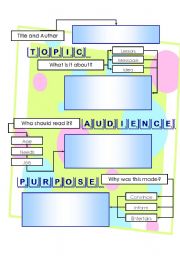
|
Graphic Organizer: Topic, Audience, and Purpose
Handy graphic organizer to help ESL students with analyzing texts, especially when preparing for non-ESL academic courses. It helps for them to be able to use the language of topic, audience, and purpose when reading/writing a text. Good for CALP.
Note: Two versions included - the second is for younger students
Level: elementary
Age: 8-17
Type: worksheet
Downloads: 17
|

|
Reading Comprehension + Vocab: Influence and Affect
Explains meaning of influence/affect. Nice and meaningful story to demonstrate use of these terms. Communicative exercise to use the terms and get students thinking about them meaningfully!
Level: intermediate
Age: 9-17
Type: Choose
Downloads: 16
|

|
Fun with Adjectives: Gross vs Scary Mood
Most young kids are intrigued by what�s scary/disgusting. Here�s an exercise to help them expand their vocabulary, make use of their thinking abilities, read an example of a disgusting poem, and have an opportunity to use vocabulary effectively to write in a specific mood. Great for all ages!
Level: elementary
Age: 6-17
Type: worksheet
Downloads: 13
|

|
Citizenship word list (activity)
A way to begin discussing "citizenship" in the classroom, or even simply, classroom rules. Vocabulary word list with pictures that students can match. They can cut and paste the pictures and match them with the proper definition. It is great because it involves a hands-on thinking activity!
Level: elementary
Age: 6-17
Type: activity-card
Downloads: 9
|

|
Creative Writing Game
Students write a story together by taking turns adding to a story. A fun way to get students to write, especially if you ask them to focus on using the past tense verb, or provide a vocabulary list they must include. Game has different names but the name I know is "Rigmarole".
Level: intermediate
Age: 10-17
Type: activity-card
Downloads: 9
|

|
Math for ESL Learners: Mean, Median, Mode, Range
A Halloween worksheet for students working with mean, median, mode, and range. Gets students thinking and applying this vocabulary in a way that is simple and will not necessarily make them feel out of place in the content classroom. Answer key + link to additional resource is provided.
Level: intermediate
Age: 11-17
Type: worksheet
Downloads: 8
|

|
Why vs How: Seeing and Knowing the Difference + Answer Key
Do your students have a hard time answering HOW and WHY questions? Some exercises to help them practice telling the difference between them. Fully editable + answer key included.
Level: intermediate
Age: 10-17
Type: worksheet
Downloads: 8
|

|
Worksheet: Reading Response (Self/World/Text Framework)
Get your students to respond to writing by making connections to the self, the world, and other texts. Foster critical reading skills. Includes focus questions for students to answer. Current version applies to narrative forms but it is fully editable and can be adapted to other text types.
Level: intermediate
Age: 9-17
Type: worksheet
Downloads: 8
|

|
Distance, Mass, and Capacity: Learning the Difference in Meaning
Help students learn math content in English and understand how to know the difference between these terms. Amusing questions will get them thinking. ANSWER KEY + Fully Editable
Level: intermediate
Age: 10-17
Type: worksheet
Downloads: 7
|

|
Math Concepts: Probability, Fair and Unfair Games
Help students understand what a fair game is by experiencing an UNFAIR game. The rules are simple and can be easily understood by ESL students as well as other students in your classroom. Useful for introducing this idea about "fairness" even outside of a mathematical lesson. And bottom line: Lots of fun! I�ve found everyone has an opinion abou...
Level: intermediate
Age: 10-17
Type: activity-card
Downloads: 3
|